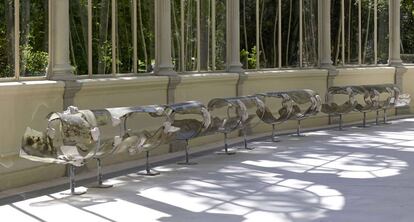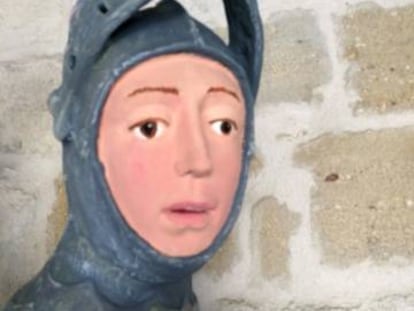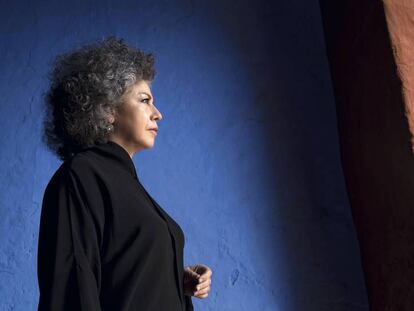Two visitors accidentally damage artworks in Madrid’s Palacio de Cristal
The Reina Sofía museum will have to pay out €13,700 to rebuild the sculptures by Iranian artist Nairy Baghramian because they were not insured

Last August, two visitors accidentally damaged sculptures by Iranian artist Nairy Baghramian at her exhibition at the Palacio de Cristal in Madrid’s central El Retiro park. The first accident happened just two days after the exhibition opened, when a tourist tripped over one of the sculptures as she was taking a photo.
“The guard saw it happening and ran to stop her from falling on the work but did not get there in time,” explains Jorge García Gómez-Tejedor, head of art restoration at the Reina Sofía museum, the modern art gallery that organized the exhibition. A day later a report by the museum confirmed that the work had been damaged.
We told her that this could happen. They are very delicate works
Jorge García Gómez-Tejedor, Reina Sofía museum
“The artist asked us to urgently fix it. She didn’t want the broken glass to be seen,” explains Gómez-Tejedor. “The works are made from very delicate material. We had to handle them with extreme care. I would not be surprised if this had happened to her before.”
Ten days later another glass sculpture, made of four parts and fixed to the floor to the left of the entrance, was damaged in another accident. “While the guard was talking to the head of security about a separate incident, a girl sat down on the piece, causing it to break and for pieces of it to shatter,” explains the second accident report, which has been seen by EL PAÍS. The child was not injured in the accident.
No insurance
“It’s glass mesh and an aluminum structure. Everything is very delicate. We told [Baghramian] that this could happen. They are very delicate works and the artist played at blending [the works] with the space and camouflaging them within the space. This also didn’t help,” says Gómez-Tejedor. “I don’t like accidents happening like this – they’re serious, not just an anecdote. But an accident can always happen, no matter how much foresight we have,” he adds.
The damage to the works will cost the state coffers €13,700 because they weren’t insured. The artist’s workshop assistant will be responsible for reproducing them. The Reina Sofía Museum says that it signed a contract that covered the cost of producing the specific project for the space, but not for insuring the particulars of the exhibition space. All artworks featured in the other Reina Sofía Museum venues are insured – all except for pieces that appear in the Palacio de Cristal.
The Baghramian exhibition cost €94,000, including the almost €14,000 for the repairs
Given that the space is located in a park, with openings where birds can fly through and potentially stain the works, the insurance budget would be “extremely high.” “They would also impose a series of conditions on us (such as barriers, paths, etc.), which most artists and curators would not agree to. We make a contract with the artists that states that, if there is any damage, as in this case, the museum will be responsible, assuming a much lower cost,” the museum explains. In the case of the Baghramian exhibition, the project cost €94,000 in total, including the almost €14,000 for the repairs.
“Invisible” artworks
Baghramian’s sculptures play with the glass and metal materials of the Palacio de Cristal. The idea behind the camouflage is to open a debate on privacy and exhibition, the interior and the exterior. During her visit to Madrid, the Iranian artist said that the color of the works, which were inspired by the space, made them “invisible.” According to the Reina Sofía, “her sculptures create organic forms with bulges and cavities.”
The pieces are also fragile and poetic, like the Palacio de Cristal itself, which was built at the end of the 19th century as a greenhouse to display exotic species from the Philippines. Last year, more than 1.6 million people visited the space, which has no entry charge. The central site of the Reina Sofía Museum, the Sabatini Building near Atocha train station, received just 50,000 more visitors.
According to Gómez-Tejedor, days before the exhibition opened the site was reviewed by security to decide how many guards would be needed to handle the visitors. “As a minimum there are two guards and another two people in charge of providing information. But everything depends on the piece.”
The Palacio de Cristal has hosted other exhibitions that involved less risk, such as the piece by Danh Vo that was hung from the roof in 2016, a two-hour audio recording of the Hudson River by German sound artist Lothar Baumgarten, and more recently, an installation by Colombian artist Doris Salcedo, where the names of migrants who had died at sea disappeared and reappeared under water.
English version by Melissa Kitson.
Tu suscripción se está usando en otro dispositivo
¿Quieres añadir otro usuario a tu suscripción?
Si continúas leyendo en este dispositivo, no se podrá leer en el otro.
FlechaTu suscripción se está usando en otro dispositivo y solo puedes acceder a EL PAÍS desde un dispositivo a la vez.
Si quieres compartir tu cuenta, cambia tu suscripción a la modalidad Premium, así podrás añadir otro usuario. Cada uno accederá con su propia cuenta de email, lo que os permitirá personalizar vuestra experiencia en EL PAÍS.
¿Tienes una suscripción de empresa? Accede aquí para contratar más cuentas.
En el caso de no saber quién está usando tu cuenta, te recomendamos cambiar tu contraseña aquí.
Si decides continuar compartiendo tu cuenta, este mensaje se mostrará en tu dispositivo y en el de la otra persona que está usando tu cuenta de forma indefinida, afectando a tu experiencia de lectura. Puedes consultar aquí los términos y condiciones de la suscripción digital.
More information
Archived In
Últimas noticias
Reinhard Genzel, Nobel laureate in physics: ‘One-minute videos will never give you the truth’
Pinochet’s victims grapple with José Antonio Kast’s rise in Chile
How Japan is trying to avert ‘digital defeat’
The complicated life of Francesca Albanese: A rising figure in Italy but barred from every bank by Trump’s sanctions
Most viewed
- Pablo Escobar’s hippos: A serious environmental problem, 40 years on
- Why we lost the habit of sleeping in two segments and how that changed our sense of time
- Charles Dubouloz, mountaineering star, retires at 36 with a farewell tour inspired by Walter Bonatti
- Trump’s obsession with putting his name on everything is unprecedented in the United States
- The Florida Keys tourist paradise is besieged by immigration agents: ‘We’ve never seen anything like this’










































